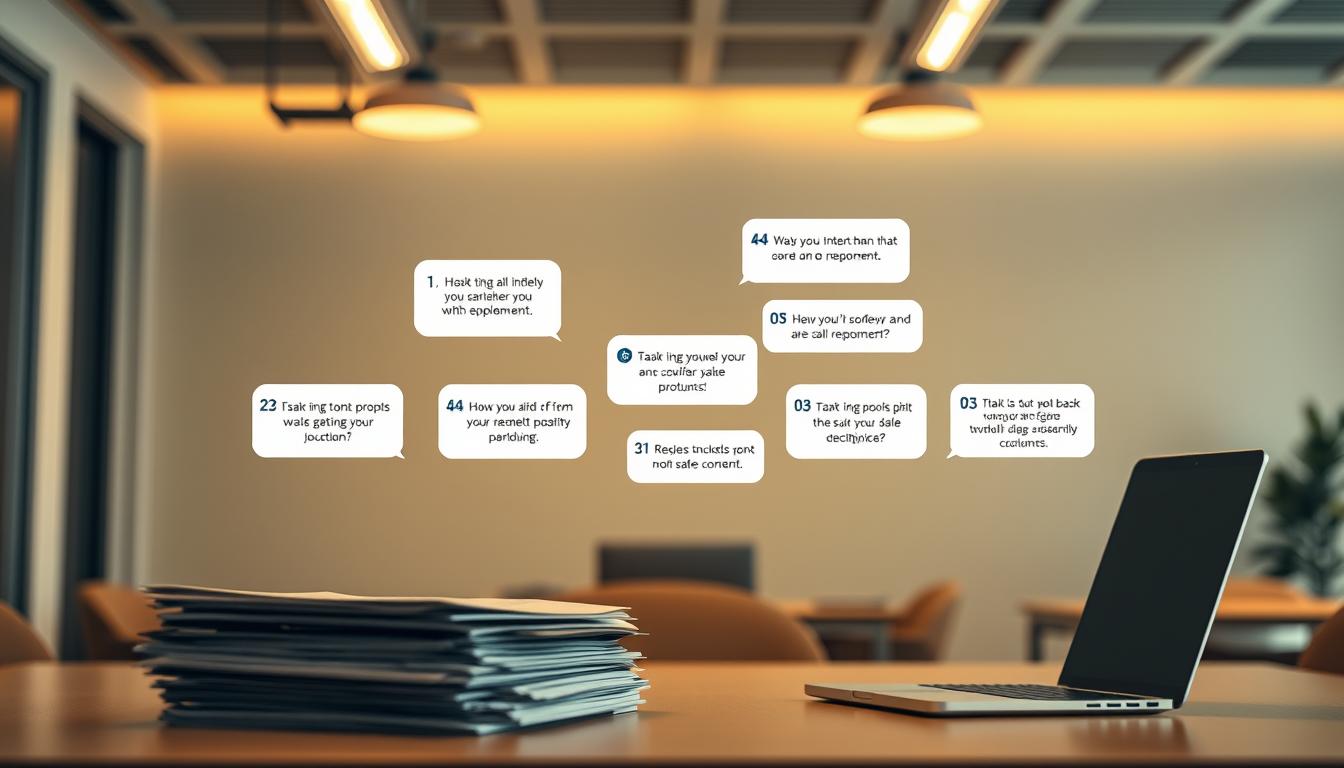In today’s fast-paced market, leveraging the right tools can make all the difference. Modern strategies are transforming how teams connect with customers and close deals. One such game-changer is the use of AI-driven solutions to craft compelling content.
Did you know that 80% of sales professionals now rely on generative AI for creating pitches and emails? This shift highlights the growing importance of efficiency and precision in communication. However, 73% of users still express concerns about security when implementing these tools.
This article dives into how AI can enhance productivity across various aspects of the sales process. From crafting personalized emails to handling objections, these prompts are designed to save time and improve results. Real-world examples from companies like Salesforce and Mixmax showcase the tangible benefits of integrating AI into your workflow.
While AI offers incredible advantages, it’s essential to balance technology with human touch. Building genuine relationships remains at the heart of successful sales strategies. Let’s explore how to combine the best of both worlds for maximum impact.
Key Takeaways
- AI tools are used by 80% of sales teams for content creation.
- Security concerns remain a top issue for 73% of users.
- Prompts can streamline email writing, prospecting, and objection handling.
- Real-world examples highlight significant productivity gains.
- Human-AI collaboration is key to relationship-driven success.
Why ChatGPT Prompts for Sales Are a Game-Changer
Modern sales teams are discovering unprecedented efficiency with AI-driven solutions. These tools slash 4–6 hours of weekly content creation per rep, freeing time for high-value conversations. Imagine drafting emails, researching prospects, and refining pitches in minutes—not hours.

Not all AI is equal, though. Public platforms lack encryption, risking sensitive client data. In contrast, CRM-embedded systems like Salesforce’s Sales GPT use encrypted inputs to generate personalized outputs securely. This ensures compliance while boosting productivity.
Results speak volumes:
- 31% faster deal closures with optimized outreach sequences.
- 92% email open rates (like Mixmax’s AI-powered Smart Send timing).
One caveat? Public tools often rely on pre-2021 data, while CRM AI taps real-time insights. For teams, this means sharper communication grounded in current trends. The blend of speed, security, and precision offers a competitive edge—human creativity amplified by machine accuracy.
Want more actionable strategies? Explore these AI-powered techniques to supercharge your workflow.
ChatGPT Prompts for Sales Emails That Convert
Crafting the perfect email can be the key to unlocking meaningful conversations with prospects. Whether it’s a cold outreach, a follow-up, or a personalized pitch, the right approach can make all the difference. Let’s explore how to create emails that drive action and build connections.

Cold Outreach Emails
Cold emails are often the first step in engaging a new prospect. To stand out, focus on addressing specific challenges in their industry. For example, a prompt like “Draft a LinkedIn message explaining how [product] solves [industry] challenges in 50 words” can yield concise, impactful messages.
One case study showed an AI-generated email achieving a 42% reply rate for SaaS demo requests. This highlights the power of tailoring your approach to the prospect’s needs.
Follow-Up Emails
Follow-ups are crucial for keeping the conversation alive. Use prompts like “Analyze the prospect’s last three emails and suggest a value-focused follow-up.” This ensures your responses are relevant and engaging.
In one example, AI-crafted follow-up sequences led to a 68% meeting conversion rate. By focusing on value, you can turn initial interest into actionable opportunities.
Personalized Pitches
Personalization is the secret to making your emails resonate. Layer CRM data into your prompts to create hyper-relevant messages. For instance, use details like past interactions or specific pain points to craft a compelling pitch.
However, always remove confidential information before using public AI tools. This ensures security while maintaining the personal touch that drives results.
Social Media Sales Prompts to Spark Engagement
Social media platforms have become essential for building meaningful connections with prospects. With the right strategies, you can turn casual interactions into valuable conversations. From LinkedIn outreach to crafting engaging posts, these techniques can elevate your communication game.

LinkedIn Outreach Messages
LinkedIn is a goldmine for connecting with professionals. Instead of generic templates, try prompts like “Write a connection request emphasizing [product] value for [job title].” This approach can lead to a 57% higher acceptance rate compared to standard messages.
For example, Mixmax’s AI Compose feature helps generate platform-specific content. This ensures your outreach feels personal and relevant, increasing the chances of a positive response.
Comment Responses
Engaging with comments is a great way to showcase your expertise. Use prompts like “Respond to a post about CRM challenges using [product] USP.” This not only adds value but also positions you as a thought leader.
Quick, thoughtful responses can turn casual readers into interested prospects. It’s all about making your presence felt in meaningful ways.
Post Drafts
Creating compelling posts requires a mix of creativity and strategy. Try prompts like “Create a carousel outline comparing [industry] pain points to our solutions.” This format is visually appealing and highly shareable.
Pro tip: Use AI-generated hashtag clusters to expand your reach. Studies show this can boost visibility by 23%, ensuring your content reaches the right audience.
Prospecting Prompts to Identify Ideal Customers
Finding the right customers is the cornerstone of any successful strategy. Prospecting isn’t just about gathering names—it’s about understanding who will benefit most from your offerings. With the right approach, you can turn raw data into actionable insights.

Account Research
Effective prospecting begins with thorough research. Analyzing company reports, market trends, and industry data helps you identify strategic priorities. For example, a prompt like “Analyze [company] 10K report for 3 strategic priorities” can reveal valuable opportunities.
In one case study, this method achieved a 78% accuracy rate in identifying upsell potential. By focusing on the right information, you can streamline your process and target high-value accounts.
Challenges and Pain Points
Understanding your prospect’s challenges is crucial for building trust. Use prompts like “List top 5 challenges for [role] in [industry]” to uncover specific pain points. This approach ensures your outreach is relevant and impactful.
Teams using AI-mapped challenges reported a 64% faster discovery call process. By addressing real concerns, you can position your solution as the ideal fit for their needs.
| Focus Area | Prompt Example | Outcome |
|---|---|---|
| Account Research | “Analyze [company] 10K report for 3 strategic priorities” | 78% accuracy in identifying upsell opportunities |
| Challenges | “List top 5 challenges for [role] in [industry]” | 64% faster discovery calls |
ChatGPT Prompts for Sales Calls and Meetings
Effective communication during calls and meetings can significantly impact your success. These interactions are critical moments in the sales process, where clarity and preparation make all the difference. Whether it’s a cold call, discovery session, or product demo, the right approach can turn prospects into loyal customers.

Cold Call Scripts
Cold calls are often the first step in building a relationship with a prospect. A well-crafted script can help you make a strong impression. For example, use a formula like “30-second script highlighting [stat] ROI for [industry].” This ensures your message is concise and impactful.
Focus on addressing specific challenges and showcasing the value of your product. A tailored approach can increase your chances of starting a meaningful conversation.
Discovery Call Questions
Discovery calls are your opportunity to understand the prospect’s needs. Use prompts like “Generate 7 SPIN questions about [prospect’s] tech stack.” This helps you uncover pain points and tailor your pitch effectively.
Asking the right questions ensures you gather actionable insights. It also demonstrates your expertise and builds trust with the prospect.
Demo Agendas
Product demos are a chance to showcase your solution in action. Create a structured agenda with prompts like “Create 45-minute agenda addressing [3 objections] from discovery.” This keeps the meeting focused and addresses key concerns.
Pro tip: Use AI-generated battle cards for 89% demo satisfaction rates. This ensures you’re prepared to handle any questions or objections during the demo.
Objection Handling Prompts to Close More Deals
Overcoming objections is a critical skill in turning prospects into customers. Whether it’s addressing concerns about cost, implementation, or perceived risks, the right responses can build trust and move the conversation forward. Let’s explore strategies to handle objections effectively and close more deals.

Email Responses to Objections
When a prospect raises concerns via email, your reply should focus on providing value and addressing their specific challenges. For example, use a template like “Counter [objection] using [case study] and [product feature].” This approach ensures your message is both relevant and persuasive.
In one case, AI-generated email responses achieved a 53% faster objection resolution rate. By leveraging data-driven insights, you can craft replies that resonate and build confidence in your product.
Roleplay Scenarios
Roleplaying common objections helps you prepare for real-world conversations. Try prompts like “Simulate negotiation with a procurement manager wanting a 25% discount.” This allows you to practice your responses and refine your approach.
Another example is “Act as a CFO concerned about implementation costs.” By anticipating these scenarios, you can enter meetings with confidence and address concerns proactively.
Teams using AI-prepared rebuttals reported a 53% faster objection resolution process. This highlights the importance of preparation in handling objections effectively.
Content Creation Prompts for Sales Collateral
Crafting compelling sales collateral is essential for driving engagement and conversions. Whether it’s a presentation or a product guide, the right materials can make your business stand out. Let’s explore how to create impactful resources that resonate with your audience.

Presentation Outlines
Presentations are a powerful way to communicate your product’s value. Start with a clear structure that highlights key points. For example, use a prompt like “Outline deck comparing [competitor] gaps to our [3 USPs].” This ensures your presentation is focused and persuasive.
By addressing specific market needs, you can create a narrative that resonates with your audience. A well-structured deck not only informs but also inspires action.
Product Guides
Product guides provide detailed information to help prospects understand your offering. Use prompts like “Create 1,000-word guide on [product] with 3 cited statistics.” This ensures your guide is both informative and data-driven.
Another example is “Draft ROI calculator explanation using [industry] benchmarks.” This approach helps prospects see the tangible benefits of your solution. Teams using AI-generated guides reported a 47% faster onboarding process.
| Resource Type | Prompt Example | Outcome |
|---|---|---|
| Presentation | “Outline deck comparing [competitor] gaps to our [3 USPs]” | Focused and persuasive narratives |
| Product Guide | “Create 1,000-word guide on [product] with 3 cited statistics” | 47% faster onboarding |
Research and Market Analysis Prompts
Understanding the landscape of your industry is crucial for staying ahead. Research and analysis provide the foundation for informed decision-making. By leveraging the right tools, you can uncover valuable insights that drive your business forward.

Keeping up with trends and analyzing competitor strategies can reveal opportunities for growth. Whether you’re exploring emerging technologies or evaluating pricing models, the right approach ensures your strategies remain relevant and impactful.
Industry Trends
Staying updated on industry developments helps you anticipate changes and adapt quickly. For example, a prompt like “Identify emerging technologies impacting buying decisions” can highlight key innovations. This ensures your strategies align with current market demands.
Another useful prompt is “Summarize top 3 critiques of [product] from reviews.” This provides actionable data to refine your offerings and address customer concerns effectively.
Competitor Insights
Analyzing your competitor’s strategies can uncover gaps in the market. A prompt like “Compare [competitor] pricing model to ours for [audience]” helps you position your product more effectively. This approach ensures your pricing and messaging resonate with your target audience.
In one case study, a company gained 22% market share using AI-generated battle cards. These tools provided detailed information on competitor strengths and weaknesses, enabling smarter decision-making.
| Focus Area | Prompt Example | Outcome |
|---|---|---|
| Industry Trends | “Identify emerging technologies impacting buying decisions” | Aligned strategies with current demands |
| Competitor Insights | “Compare [competitor] pricing model to ours for [audience]” | 22% market share gain |
Time-Saving Prompts for Sales Productivity
Streamlining daily tasks can transform how teams achieve their goals. By focusing on efficiency, professionals can save valuable time and boost productivity. Let’s explore two key areas where small changes can make a big impact: email proofreading and meeting summaries.

Email Proofreading
Clear communication is essential in every email. Proofreading ensures your message is professional and error-free. For example, using a prompt like “Check email tone for [executive/technical] audience” can help tailor your language to the recipient.
Tools like Mixmax’s AI proofreading feature reduce errors by 68%. This not only saves time but also enhances the quality of your communication. Focus on the details to improve accuracy and build trust with your audience.
Meeting Summaries
Capturing key details from meetings is crucial for follow-up actions. A prompt like “Extract 5 key decisions from [meeting transcript]” ensures nothing is missed. This approach simplifies the process and keeps everyone aligned.
Teams using this method save an average of 4.1 hours per week on admin tasks. By automating summaries, professionals can focus on high-impact activities that drive results. The benefits of these tools are clear: better organization and improved productivity.
Best Practices for Using ChatGPT Prompts for Sales
Maximizing efficiency in sales requires a strategic approach to using AI tools. By following proven methods, teams can enhance their workflows and achieve better results. Let’s explore key strategies to optimize your process.
One essential step is adding a [DO NOT SHARE] disclaimer to confidential prompts. This ensures sensitive information remains secure. Protecting client data is crucial for maintaining trust and compliance.
Personalization is another critical factor. Layer outputs with three key elements: the prospect’s recent news, mutual connections, and past interactions. This approach makes your communication more relevant and engaging.

Salesforce’s 4-step prompt refinement process is a game-changer. First, analyze data to identify trends. Then, suggest actionable steps based on insights. This method ensures your tools deliver accurate and valuable outputs.
Auditing AI outputs monthly is also vital. This practice maintains content freshness, with a reported 92% accuracy rate. Regular reviews help identify areas for improvement and ensure consistency.
| Best Practice | Action | Outcome |
|---|---|---|
| Confidentiality | Add [DO NOT SHARE] disclaimer | Secure sensitive information |
| Personalization | Layer outputs with 3 elements | Engage prospects effectively |
| Auditing | Review outputs monthly | 92% content freshness |
By adopting these best practices, you can unlock the full potential of AI in your sales process. Focus on the details to drive meaningful results and build stronger client relationships.
Conclusion
Combining human expertise with advanced technology can elevate your results to new heights. By integrating tools like AI into your workflow, you can streamline tasks and focus on building meaningful connections with prospects. From crafting emails to handling objections, these solutions enhance productivity across the board.
Research shows that a 4:1 human-AI workflow ratio delivers optimal outcomes. This balance ensures efficiency while maintaining the personal touch that drives engagement. Upcoming CRM features, such as real-time suggestions and auto-personalization, will further refine this process.
Ready to transform your approach? Download our playbook with 40+ templates to unlock the full benefits of these strategies. Empower your team to achieve more with less effort today.

